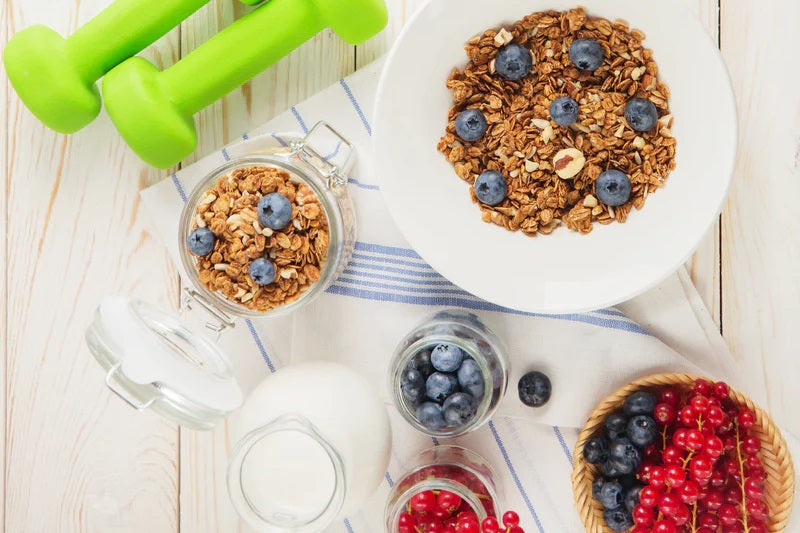The Before and After of a Great Workout
Who doesn’t love spontaneity—that exciting moment when you drop what you are doing to follow a whim, a passion, an experience. For example, taking a road trip, skydiving, or trying deep-fried water (Google) or a Maggi Milkshake (Googling not recommended).
That said, spontaneity never, ever applies to a workout. If you want to get the most out of your fitness goals (and not hurt yourself in the process), pay close attention to the “befores” and “afters”, especially when it comes to nutrition.
Prepping for a workout requires your body be properly rested, properly warmed up, and properly fueled and hydrated. Otherwise, your energy, endurance, and focus will wane, leaving you tired, discouraged, and inadequately nourished. Likewise, following a workout, you need to refuel properly to prevent muscle breakdown and to restore glycogen levels for future fuel.
The two things you don’t want to be prior to a workout are starving or full. It’s best to eat a balanced meal of carbs, protein, and healthy fats (about 1000 calories) up to 2 hours before, or a quick snack (300-400 calories) that is low in fiber but contains easily digestible carbs and a little protein up to one half hour before. The body needs time to digest in order for you to get the nutritional benefits.
You can go for more fiber and carbs if you are eating a full meal a couple of hours before. But stay the heck away from high-fat, high-fiber foods, and fast-foods. Heavy meals hijack blood and oxygen supplies for digestion, taking it away from our muscles. This can result in less energy and muscle cramps. Also, don’t consume soda, energy drinks and smoothies with high sugar content, or (needless to say) alcohol that can over-stimulate or depress your system. And, whatever you do, don’t fast before a workout.
Here are some suggestions for pre-workout foods and snacks.
Fruit: bananas or apples alone or paired with a nut butter
Low- or non-fat Yogurt/Cottage Cheese: add whole or dried fruit or granola
Oatmeal: add whole or dried berries
Protein Shake: mix it up and enjoy
Bagel: add peanut butter or hummus
Eggs: hard-boiled
Water: 20 ounces
Other Liquids: coffee or natural fruit juice in addition to water
So, now your workout is done, but your body is still humming along. It’s time to refuel and this should be done within 30 to 60 minutes. A healthy combo of carbohydrates, high-quality proteins, and fluids will provide hydration, build and repair muscle, and restore glycogen levels.
A recommended ratio for recovery is 2(or 3):1 carb-to-protein. So maybe 5 grams of protein to 15 to 30 grams of carbs, going higher or lower depending on the intensity of the workout. Strength training requires more protein, whereas cardio needs more carbs. Another good metric to follow is a meal that consists of one-third fruits and vegetables, one-third protein, one-third complex carbohydrates. In any case, make it a balance. Don’t have just protein or just carbs and—very important—don’t overeat because you are famished.
Following are some food suggestions for recovery:
Omelet: add veggies and cheese and have with whole grain bread
Sandwich: lean protein like turkey with avocado and tomato or grilled veggies and humus in a whole wheat pita or wrap
Stir-fry: lean protein like shrimp or chicken, plus veggies served over quinoa or brown rice
Plain Greek Yogurt: with dried or whole fruit and honey
Smoothie: this is the time for your favorite smoothie mixed with fruit, greens, and some protein
Chocolate Milk: a real treat with all of the carbs, protein, fluids, and electrolytes you need
In addition to good nutrition, experts recommend some other pre- and post-workout DOs and DON’Ts.
- Don’t try a new supplement or take over-the-counter medications before a workout.
- Do dynamic stretching (quick), not static stretching (holding stretches) prior to a workout. Save the static stretching for afterwards.
- Do get enough rest the night before your morning workout, but don’t nap more than 30 minutes before a late day session.
- Do notice the color of your urine (dark or light) as a test of how hydrated you are.
- Don’t stay in your sweaty colors where bacteria may linger.
Proper fitness takes time and commitment well beyond the hour you spend on the treadmill, yoga mat, or in the lap pool. Following some simple pre- and post-workout guidelines will give you enduring results and maybe the energy to jump out of that plane.


